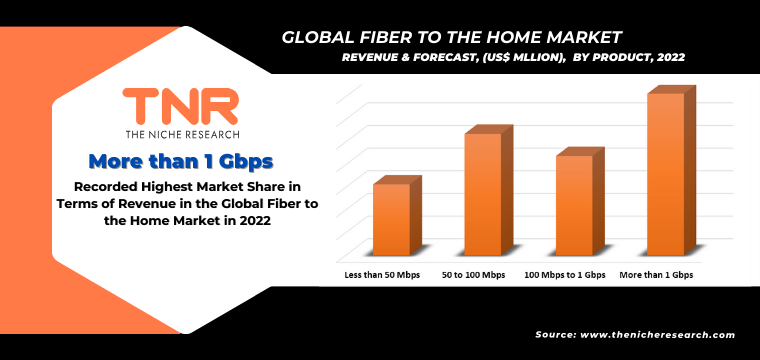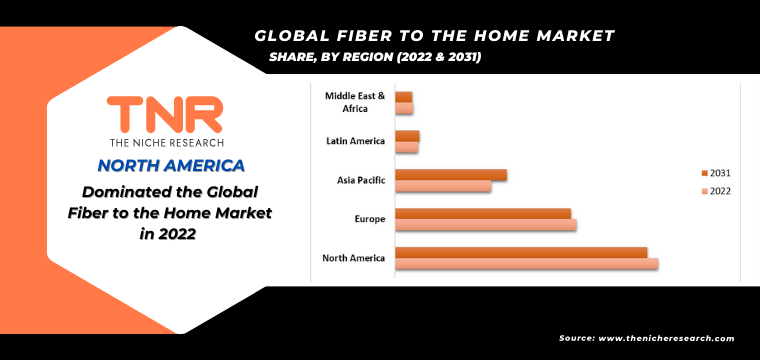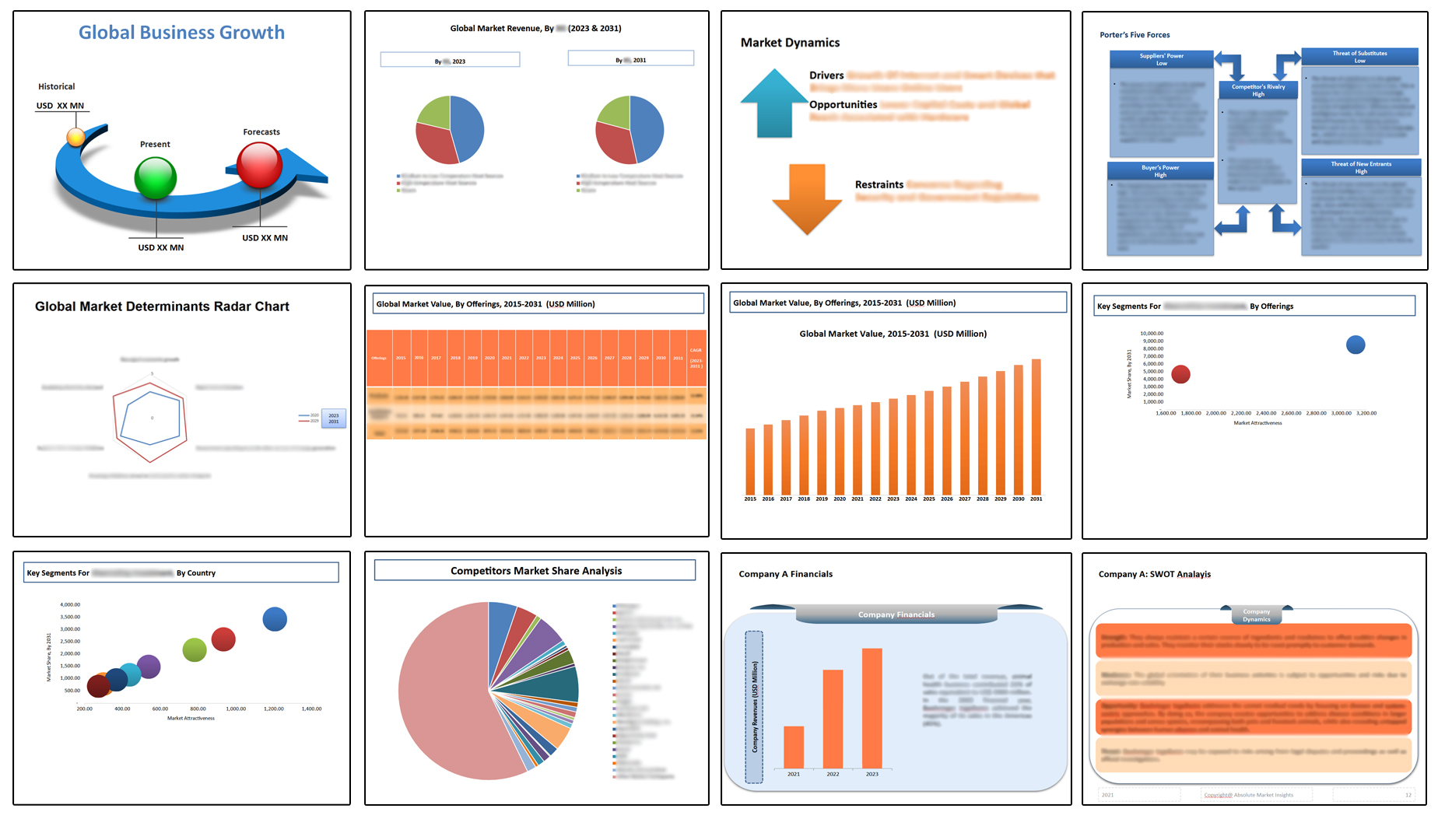Global Fiber to the Home Market, By Product, By Service Provider, By Application, By Region & Segmental Insights Trends and Forecast, 2023 – 2031
- Industry: Technology
- Report ID: TNR-110-1027
- Number of Pages: 420
- Table/Charts : Yes
- November, 2023
- Base Year : 2024
- No. of Companies : 11+
- No. of Countries : 29
- Views : 10310
- Covid Impact Covered: Yes
- War Impact Covered: Yes
- Formats : PDF, Excel, PPT
Fiber to the Home is a high-speed internet connectivity technology that delivers data using optical fiber directly to residential buildings. It offers ultra-fast internet speeds, low latency, and reliable connections, enabling seamless streaming, gaming, and other online activities. Fiber to the Home enhances digital experiences for households by providing efficient and robust internet access. In terms of revenue, the global fiber to the home market was worth US$ 48.45 Bn in 2022, anticipated to witness CAGR of 10.7% during 2023 – 2031.
Global Fiber to the Home Market Revenue & Forecast, (US$ Million), 2015 – 2031

Trends in the Global Fiber to the Home Market
- The demand for high-speed internet is continuously increasing as more people engage in bandwidth-intensive activities like online gaming, video streaming, and remote work. With the current trend of remote work arrangements and online education, there’s a pressing need for faster and more reliable internet connections, which Fiber to the Home technology is well-suited to provide. This heightened demand is driving the expansion of Fiber to the Home networks to meet the growing bandwidth requirements of households.
- Telecommunications companies are actively modernizing their networks to support emerging technologies like 5G and IoT. Fiber to the Home plays a crucial role in this transformation, as it provides the necessary infrastructure for high-capacity data transfer and low-latency connections. This ongoing trend of digital transformation is fueling investments in fiber to the home market deployment to enable seamless connectivity and to stay competitive in the evolving telecommunications landscape.

100 Mbps to 1 Gbps segment has gained popularity in recent years and is anticipated to be the fastest growing segment in the global fiber to the home market during the forecast period. While offering remarkable speed, it strikes a balance between cost and performance, making it an attractive choice for a wide range of users. This segment caters to the majority of residential and small business needs, encompassing activities like HD streaming, remote work, and online gaming. With a surge in remote work and digital content consumption, this segment is witnessing substantial growth. It meets the evolving connectivity demands of users, positioning itself as a popular and adaptable choice in the Fiber to the Home market.
Telecom Operators, among service providers, had the highest share in the global fiber to the home market in 2022. The dominance is driven by its extensive infrastructure, experience, and established customer base. Major telecom operators possess the resources to invest in and deploy Fiber to the Home networks on a large scale. For example, as of 2021, AT&T had over 14.5 million Fiber to the Home customers in the US. Telecom giants also offer bundled services, including internet, TV, and phone, attracting a broad customer demographic. Their ability to reach urban and remote areas, coupled with a reputation for reliability, solidifies their leadership in delivering high-speed fiber-optic connectivity to homes worldwide.

Among regions, Middle East and Africa is expected to witness the highest growth rate in the fiber to the home market during the forecast period. This growth is driven by the increasing demand for high-speed internet access due to digital transformation efforts, rising urbanization, and expanding economies in the region. Countries like the United Arab Emirates and South Africa are witnessing significant Fiber to the Home deployment. Moreover, governments are actively investing in broadband infrastructure, aiming to bridge the digital divide. As the Middle East and Africa embrace online education, e-commerce, and digital services, the demand for fast, reliable connectivity continues to surge, making Fiber to the Home the preferred choice for broadband access.
Competitive Landscape
Some of the players operating in the fiber to the home market are
- AT&T Intellectual Property
- CenturyLink
- CSC Holdings, LLC
- Etisalat
- Frontier Communications Parent, Inc.
- Singtel
- SoftBank Corp
- Verizon
- Windstream Intellectual Property Services, LLC
- Ziply Fiber
- Other Industry Participants
Global Fiber to the Home Market Snapshot
| Report Specifications | Details |
| Market Revenue in 2022 | US$ 48.45 Bn |
| Market Size Forecast by 2031 | US$ 89.34 Bn |
| Growth Rate (CAGR) | 10.7% |
| Historic Data | 2015 – 2021 |
| Base Year for Estimation | 2022 |
| Forecast Period | 2023 – 2031 |
| Report Inclusions | Market Size & Estimates, Market Dynamics, Competitive Scenario, Trends, Growth Factors, Market Determinants, Key Investment Segmentation, Product/Service/Solutions Benchmarking |
| Segments Covered | By Product, By Service Provider, By Application |
| Regions Covered | North America, Europe, Asia Pacific, Middle East & Africa, Latin America |
| Countries Covered | U.S., Canada, Mexico, Rest of North America, France, The UK, Spain, Germany, Italy, Nordic Countries (Denmark, Finland, Iceland, Sweden, Norway), Benelux Union (Belgium, The Netherlands, Luxembourg), Rest of Europe, China, Japan, India, New Zealand, Australia, South Korea, Southeast Asia (Indonesia, Thailand, Malaysia, Singapore, Rest of Southeast Asia), Rest of Asia Pacific, Saudi Arabia, UAE, Egypt, Kuwait, South Africa, Rest of Middle East & Africa, Brazil, Argentina, Rest of Latin America |
| Key Players | AT&T Intellectual Property, CenturyLink, CSC Holdings, LLC, Etisalat, Frontier Communications Parent, Inc., Singtel, SoftBank Corp, Verizon, Windstream Intellectual Property Services, LLC, Ziply Fiber, Other Industry Participants |
| Customization Scope | Customization allows for the inclusion/modification of content pertaining to geographical regions, countries, and specific market segments. |
| Pricing & Procurement Options | Explore purchase options tailored to your specific research requirements |
| Contact Details | Consult With Our Expert
Japan (Toll-Free): +81 663-386-8111 South Korea (Toll-Free): +82-808- 703-126 Saudi Arabia (Toll-Free): +966 800-850-1643 United Kingdom: +44 753-710-5080 United States: +1 302-232-5106 E-mail: askanexpert@thenicheresearch.com
|
Global Fiber to the Home Market
By Product
- Less than 50 Mbps
- 50 to 100 Mbps
- 100 Mbps to 1 Gbps
- More than 1 Gbps
By Service Provider
- Telecom Operators
- Internet Service Providers
- Cable Operators
- Other Broadband service providers
By Application
- Internet TV
- VoIP
- Interactive Gaming
- Smart Home Application
- Virtual Private LAN Service
- Remote Education
- VPN on Broadband
By Region
- North America (U.S., Canada, Mexico, Rest of North America)
- Europe (France, The UK, Spain, Germany, Italy, Nordic Countries (Denmark, Finland, Iceland, Sweden, Norway), Benelux Union (Belgium, The Netherlands, Luxembourg), Rest of Europe)
- Asia Pacific (China, Japan, India, New Zealand, Australia, South Korea, Southeast Asia (Indonesia, Thailand, Malaysia, Singapore, Rest of Southeast Asia), Rest of Asia Pacific)
- Middle East & Africa (Saudi Arabia, UAE, Egypt, Kuwait, South Africa, Rest of Middle East & Africa)
- Latin America (Brazil, Argentina, Rest of Latin America)
Report Coverage & Deliverables

Table of Contents
**Exclusive for Multi-User and Enterprise User.
Global Fiber to the Home Market
By Product
By Service Provider
By Application
By Region
Note: This ToC is tentative and can be changed according to the research study conducted during the course of report completion
**Exclusive for Multi-User and Enterprise User.
The Niche Research approach encompasses both primary and secondary research methods to provide comprehensive insights. While primary research is the cornerstone of our studies, we also incorporate secondary research sources such as company annual reports, premium industry databases, press releases, industry journals, and white papers.
Within our primary research, we actively engage with various industry stakeholders, conducting paid interviews and surveys. Our meticulous analysis extends to every market participant in major countries, allowing us to thoroughly examine their portfolios, calculate market shares, and segment revenues.
Our data collection primarily focuses on individual countries within our research scope, enabling us to estimate regional market sizes. Typically, we employ a bottom-up approach, meticulously tracking trends in different countries. We analyze growth drivers, constraints, technological innovations, and opportunities for each country, ultimately arriving at regional figures.Our process begins by examining the growth prospects of each country. Building upon these insights, we project growth and trends for the entire region. Finally, we utilize our proprietary model to refine estimations and forecasts.
Our data validation standards are integral to ensuring the reliability and accuracy of our research findings. Here’s a breakdown of our data validation processes and the stakeholders we engage with during our primary research:
- Supply Side Analysis: We initiate a supply side analysis by directly contacting market participants, through telephonic interviews and questionnaires containing both open-ended and close-ended questions. We gather information on their portfolios, segment revenues, developments, and growth strategies.
- Demand Side Analysis: To gain insights into adoption trends and consumer preferences, we reach out to target customers and users (non-vendors). This information forms a vital part of the qualitative analysis section of our reports, covering market dynamics, adoption trends, consumer behavior, spending patterns, and other related aspects.
- Consultant Insights: We tap into the expertise of our partner consultants from around the world to obtain their unique viewpoints and perspectives. Their insights contribute to a well-rounded understanding of the markets under investigation.
- In-House Validation: To ensure data accuracy and reliability, we conduct cross-validation of data points and information through our in-house team of consultants and utilize advanced data modeling tools for thorough verification.
The forecasts we provide are based on a comprehensive assessment of various factors, including:
- Market Trends and Past Performance (Last Five Years): We accurately analyze market trends and performance data from preceding five years to identify historical patterns and understand the market’s evolution.
- Historical Performance and Growth of Market Participants: We assess the historical performance and growth trajectories of key market participants. This analysis provides insights into the competitive landscape and individual company strategies.
- Market Determinants Impact Analysis (Next Eight Years): We conduct a rigorous analysis of the factors that are projected to influence the market over the next eight years. This includes assessing both internal and external determinants that can shape market dynamics.
- Drivers and Challenges for the Forecast Period:Identify the factors expected to drive market growth during the forecast period, as well as the challenges that the industry may face. This analysis aids in deriving an accurate growth rate projection.
- New Acquisitions, Collaborations, or Partnerships: We keep a close watch on any new acquisitions, collaborations, or partnerships within the industry. These developments can have a significant impact on market dynamics and competitiveness.
- Macro and Micro Factors Analysis:A thorough examination of both macro-level factors (e.g., economic trends, regulatory changes) and micro-level factors (e.g., technological advancements, consumer preferences) that may influence the market during the forecast period.
- End-User Sentiment Analysis: To understand the market from the end-user perspective, we conduct sentiment analysis. This involves assessing the sentiment, preferences, and feedback of the end-users, which can provide valuable insights into market trends.
- Perspective of Primary Participants: Insights gathered directly from primary research participants play a crucial role in shaping our forecasts. Their perspectives and experiences provide valuable qualitative data.
- Year-on-Year Growth Trend: We utilize a year-on-year growth trend based on historical market growth and expected future trends. This helps in formulating our growth projections, aligning them with the market’s historical performance.
Research process adopted by TNR involves multiple stages, including data collection, validation, quality checks, and presentation. It’s crucial that the data and information we provide add value to your existing market understanding and expertise. We have also established partnerships with business consulting, research, and survey organizations across regions and globally to collaborate on regional analysis and data validation, ensuring the highest level of accuracy and reliability in our reports.









